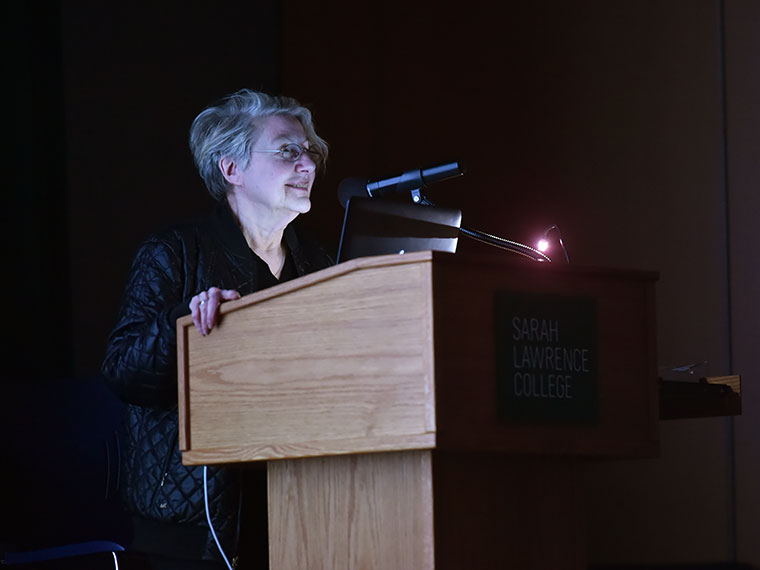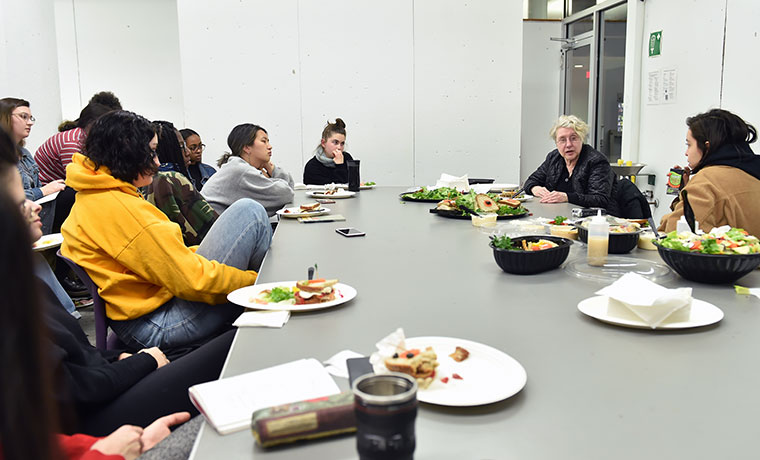March 6, 2018
 During the Vietnam War, multimedia artist Martha Rosler was disturbed by what had become a new dinnertime ritual: turning on the television to see upsetting images of the war abroad. At her Visual Arts Lecture, which took place on March 6, Rosler explained, “At the time, it was shocking that you could sit down to dinner…and be watching people in their burning huts or being bombed and this was seemingly OK with people. I thought, there is a problem of empathy and identification.”
During the Vietnam War, multimedia artist Martha Rosler was disturbed by what had become a new dinnertime ritual: turning on the television to see upsetting images of the war abroad. At her Visual Arts Lecture, which took place on March 6, Rosler explained, “At the time, it was shocking that you could sit down to dinner…and be watching people in their burning huts or being bombed and this was seemingly OK with people. I thought, there is a problem of empathy and identification.”
Spurred on by stark images of war, Rosler felt that, in addition to participating in protest marches, she needed to incorporate anti-war sentiments into her art. She then began House Beautiful: Bringing the War Home, c. 1967–1972, a series of photomontages that juxtapose real-life images of injured Vietnamese citizens with high-end homes in the US. At the time, she was invited to display this body of work in galleries, but Rosler opted to photocopy the photomontages and hand them out as fliers at protests. “I thought it would be obscene to show pictures of people who were victims of a current war in an art gallery,” she said.
All of Rosler’s works—whether video, print, photo, photomontage, or installation—pose profound questions for the viewer to contemplate. For example, Body Beautiful, or Beauty Knows No Pain, c. 1966-1972, a series of photomontages exploring representations of women’s bodies in various forms of media, was a direct outgrowth of questions she had been wondering herself, such as, “How do we know how to be women?” and “Who tells us?”
The questions that her work continues to raise—including those about democracy, education, and citizenship—couldn’t be timelier. Rosler’s visit to the College was part of the Inaugural Year Speaker Series exploring Democracy and Education, and she was introduced by faculty member Joel Sternfeld, the Noble Foundation Chair in Art and Cultural History, who called her “a giant of culture and art in our society.”
Faculty member John O’Connor (visual arts) said that Rosler, whose writing, like her art, has received international recognition, was a natural fit for the series. “The themes of her work are very relevant to what our students are thinking about,” O’Connor noted. “Her work reveals historical patterns—how ideas and issues of the past are still relevant today. That’s illuminating for students.”
In her presentation, Rosler covered select works throughout the decades, including a second iteration of her earlier anti-war photomontages, called House Beautiful: Bringing the War Home, New Series, c. 2004-2008, which was sparked by the US invasion of Iraq and Afghanistan. When colleagues questioned why Rosler might go back to her earlier use of photomontage (which is not standard practice in the art world), Rosler retorted, “Why did we go back to war? What are we doing, attacking yet another country that did not attack us?”

After her talk, Rosler had dinner with 20 visual arts students. Their conversation covered topics such as politics, race, and class as it relates to art, as well as museums as educational institutions. Under O’Connor’s guidance, the students who attended are looking into designing and publishing an edition of the post-lecture conversation, along with curated images.
Sophomore Paige McCray, who has been an admirer of the acclaimed artist for years, found Rosler’s lecture and the subsequent dialogue inspiring. She said, “It’s a huge honor and pleasure to have Martha Rosler here. She is so engaging, and her work and the questions she asks in that work remain so relevant, with all their complexities.”